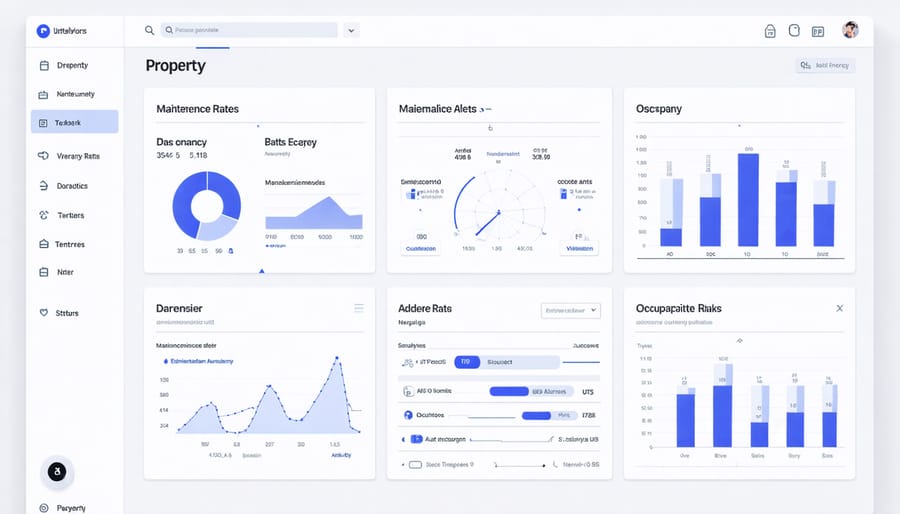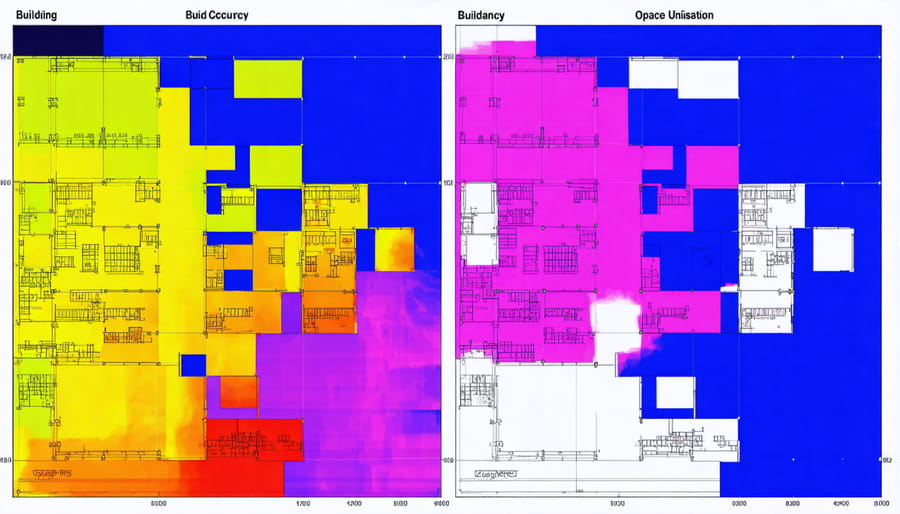Transform property management operations by harnessing the power of data analytics to drive precise, profit-focused decisions across your portfolio. Modern building management demands sophisticated analysis of occupancy patterns, maintenance records, and financial performance metrics to optimize asset value and operational efficiency.
Data analytics revolutionizes property management by converting vast amounts of building performance data, tenant behavior patterns, and market trends into actionable intelligence. Property managers leveraging advanced analytics consistently report 15-20% reductions in operational costs, 25% improvements in tenant satisfaction, and significant increases in property values through data-driven decision making.
From predictive maintenance algorithms that prevent costly equipment failures to automated tenant screening systems that reduce vacancy rates, data analytics provides property managers with unprecedented control over their assets. Real-time monitoring systems now enable instant response to maintenance issues, while sophisticated forecasting models help optimize rental pricing strategies and identify emerging market opportunities.
The integration of IoT sensors, smart building systems, and advanced analytics platforms creates a comprehensive ecosystem that transforms raw data into strategic advantages. Forward-thinking property managers who embrace these technological solutions position themselves at the forefront of an industry increasingly driven by data-backed insights and automated optimization.

Real-Time Property Performance Monitoring
Predictive Maintenance Systems
Predictive maintenance systems, powered by advanced data analytics and IoT smart buildings technology, are revolutionizing how property managers approach equipment maintenance and asset lifecycle management. These systems utilize real-time sensor data, historical performance metrics, and machine learning algorithms to forecast potential equipment failures before they occur.
By continuously monitoring critical parameters such as vibration patterns, temperature fluctuations, and energy consumption, predictive maintenance platforms can detect subtle changes that might indicate impending issues. For instance, HVAC systems equipped with smart sensors can alert facility managers to declining performance weeks before a traditional inspection would identify problems.
Recent case studies demonstrate that properties implementing predictive maintenance solutions achieve 25-30% reduction in maintenance costs and up to 75% decrease in unexpected equipment failures. The system’s AI-driven analytics engine processes vast amounts of data to create optimal maintenance schedules, ensuring interventions occur at the most cost-effective times.
Property managers can prioritize maintenance activities based on actual equipment condition rather than fixed schedules, eliminating unnecessary maintenance while preventing costly breakdowns. This data-driven approach also extends equipment lifespan, improves tenant satisfaction through reduced disruptions, and provides detailed insights for future capital planning decisions.
Energy Consumption Optimization
Data analytics has revolutionized sustainable energy management practices in property management, enabling precise monitoring and optimization of energy consumption patterns. By leveraging IoT sensors and advanced analytics platforms, property managers can now track real-time energy usage across multiple building systems, from HVAC to lighting.
Recent case studies demonstrate that buildings implementing data-driven energy management solutions achieve 15-25% reduction in energy costs within the first year. These systems analyze historical consumption data, weather patterns, and occupancy rates to create predictive models that automatically adjust building systems for optimal efficiency.
Smart algorithms detect anomalies in energy usage patterns, alerting facility managers to potential equipment malfunctions or inefficiencies before they escalate into costly problems. For instance, the Metropolitan Office Complex in Chicago reduced its annual energy expenses by $380,000 through predictive maintenance and real-time adjustments based on occupancy data.
Machine learning algorithms continuously refine these systems, learning from historical performance data to make increasingly accurate predictions about energy needs. This enables proactive maintenance scheduling and dynamic load balancing, ensuring that energy resources are allocated efficiently across different zones and time periods.
Integration with building automation systems (BAS) allows for automated responses to changing conditions, maintaining optimal comfort levels while minimizing energy waste. This data-driven approach not only reduces operational costs but also supports environmental sustainability goals and compliance with energy regulations.
Tenant Experience Enhancement
Space Utilization Analytics
Space utilization analytics leverages sensor technology, occupancy data, and advanced algorithms to provide property managers with actionable insights into how building spaces are being used. By monitoring foot traffic patterns, desk usage in office environments, and common area occupancy rates, managers can make data-driven decisions to optimize space allocation and enhance operational efficiency.
Modern analytics platforms integrate data from multiple sources, including IoT sensors, access control systems, and booking platforms, to create comprehensive usage profiles. These systems can identify underutilized areas, peak usage times, and traffic flow patterns, enabling property managers to implement strategic space modifications that better serve occupant needs.
Real-time occupancy monitoring helps facility managers maintain optimal capacity levels, particularly crucial in the post-pandemic environment where social distancing and space management have become priority concerns. The data collected can inform decisions about lease negotiations, renovation projects, and space redistribution to maximize property value and tenant satisfaction.
Advanced analytics tools can also predict future space requirements based on historical usage patterns and growth projections. This predictive capability allows property managers to proactively adapt their spaces to evolving tenant needs, potentially reducing vacancy rates and improving property ROI through more efficient space utilization.

Service Request Management
Service request management in property management has been revolutionized through data analytics, enabling property managers to optimize maintenance operations and enhance tenant satisfaction. By analyzing historical maintenance data, patterns in service requests, and resource allocation, property managers can implement predictive maintenance strategies and streamline their response protocols.
Modern analytics platforms track key metrics such as response times, completion rates, and recurring issues across properties. This data-driven approach allows managers to prioritize maintenance tasks based on urgency, potential impact, and available resources. For instance, a water leak affecting multiple units would receive immediate attention compared to a cosmetic repair request.
Machine learning algorithms can now predict maintenance needs before they become critical issues. By analyzing factors such as equipment age, usage patterns, and environmental conditions, these systems generate maintenance schedules that reduce emergency repairs and extend asset lifecycles.
Case studies have shown that properties implementing data-driven service request management typically experience a 30% reduction in response times and a 25% decrease in maintenance costs. Additionally, the systematic collection and analysis of maintenance data helps identify trending issues, enabling property managers to make informed decisions about equipment upgrades and preventive maintenance investments.
This analytical approach ensures optimal resource allocation while maintaining high service standards and tenant satisfaction levels.
Financial Performance Optimization
Revenue Optimization Strategies
Modern property management firms are leveraging predictive analytics to revolutionize their revenue optimization strategies and maximize property value through data-driven decision-making. By analyzing historical rental data, market trends, and demographic information, property managers can now determine optimal rental prices with unprecedented accuracy.
Advanced algorithms process multiple variables including seasonal demand patterns, local economic indicators, and competitive pricing to generate dynamic pricing models. These models adjust rental rates in real-time, responding to market conditions and occupancy levels to ensure maximum revenue generation while maintaining competitive positioning.
Revenue management systems integrate with property management platforms to track key performance indicators (KPIs) such as yield per square foot, tenant retention rates, and revenue per available unit. This integration enables property managers to identify underperforming assets and implement targeted improvements.
Case studies have shown that properties implementing data-driven pricing strategies typically see a 3-7% increase in revenue compared to traditional pricing methods. For example, a leading commercial property firm in Chicago reported a 5.2% revenue increase within six months of implementing predictive analytics for their pricing strategy.
The system’s ability to forecast market trends also helps property managers anticipate demand fluctuations and adjust their marketing strategies accordingly, ensuring optimal occupancy rates throughout the year. This proactive approach to revenue management has become essential for maintaining competitive advantage in today’s dynamic real estate market.
Operating Cost Analysis
Data analytics has revolutionized operating cost management in property operations by enabling managers to identify and optimize expenditure patterns across multiple cost centers. Through sophisticated analysis of utility consumption, maintenance records, and operational data, property managers can now pinpoint inefficiencies and implement targeted cost-reduction strategies.
Real-time monitoring systems track energy usage patterns, allowing for immediate detection of anomalies that could indicate equipment malfunction or inefficient operations. For instance, analysis of HVAC performance data across multiple properties has helped managers reduce energy costs by 15-25% through optimized scheduling and preventive maintenance.
Predictive analytics algorithms process historical maintenance data to forecast potential equipment failures, enabling proactive repairs that cost significantly less than emergency interventions. Studies show that predictive maintenance can reduce repair costs by up to 40% while extending asset life cycles.
Labor cost optimization benefits from workforce analytics that examine staff utilization rates and maintenance response times. This data helps property managers make informed decisions about staffing levels, contractor selection, and resource allocation, often resulting in 10-15% reduction in labor-related expenses.
Additionally, automated vendor payment systems coupled with spend analytics provide insights into procurement patterns, helping identify opportunities for bulk purchasing and contract optimization. Property managers using these systems report average savings of 12% on supply chain costs while maintaining or improving service quality.
These data-driven insights enable property managers to develop evidence-based budgets and make strategic decisions that significantly impact the bottom line while maintaining high service standards.
Implementation Strategies

Technology Infrastructure Requirements
Implementing effective data analytics in property management requires a robust technological foundation comprising several key components. At the core of this infrastructure are property management software solutions that integrate seamlessly with data collection and analysis tools.
Cloud-based storage systems form the backbone of data infrastructure, providing secure and scalable storage for vast amounts of property-related information. These systems should support real-time data access and maintain high availability for multiple users across different locations.
Advanced sensors and IoT devices are essential for collecting real-time data from various building systems, including HVAC, lighting, security, and occupancy monitoring. These devices should be equipped with reliable connectivity options such as Wi-Fi, cellular, or low-power wide-area networks (LPWAN).
Data processing capabilities must include both edge computing solutions for immediate analysis and centralized processing systems for comprehensive analytics. High-performance computing resources are necessary for handling complex algorithms and machine learning models.
Visualization tools and dashboards are crucial for presenting analyzed data in an accessible format. These should offer customizable interfaces, interactive features, and mobile compatibility for on-the-go access.
Security infrastructure is paramount, requiring robust encryption, access control systems, and regular security updates to protect sensitive property and tenant data. Additionally, backup systems and disaster recovery protocols must be in place to ensure data continuity and reliability.
Data Security and Compliance
In the era of data-driven property management, securing sensitive information and maintaining regulatory compliance are paramount concerns. Property managers must implement robust data security protocols to protect tenant information, financial records, and operational data while ensuring compliance with relevant regulations such as GDPR, CCPA, and industry-specific requirements.
A comprehensive data security framework should include encrypted data storage systems, secure access controls, and regular security audits. Property management firms should establish clear data handling protocols, including data classification, retention policies, and disposal procedures. Multi-factor authentication and role-based access control help prevent unauthorized data access while maintaining operational efficiency.
Regular staff training on data security best practices is essential, as human error remains a significant risk factor. This includes education on phishing prevention, secure password management, and proper handling of sensitive information. Property managers should also maintain detailed audit trails of data access and modifications to ensure accountability and facilitate compliance reporting.
When implementing analytics solutions, it’s crucial to work with vendors who prioritize data security and maintain relevant certifications. Data processing agreements should clearly outline responsibilities for data protection, breach notification procedures, and compliance requirements. Regular security assessments and penetration testing help identify and address potential vulnerabilities before they can be exploited.
Backup and disaster recovery plans must be regularly tested and updated to ensure business continuity in case of data breaches or system failures. Property managers should also maintain documentation of their compliance efforts and security measures for regulatory audits and stakeholder assurance.
Data analytics has fundamentally transformed property management, delivering unprecedented insights and operational efficiencies across the industry. The integration of advanced analytics tools has enabled property managers to make data-driven decisions, optimize resource allocation, and enhance tenant satisfaction while maximizing return on investment.
The benefits of implementing data analytics solutions are clear and measurable: reduced operational costs, improved maintenance scheduling, enhanced energy efficiency, and more effective tenant relationship management. Property managers who have embraced these technologies report significant improvements in occupancy rates, faster response times to maintenance issues, and more accurate financial forecasting.
Looking ahead, the role of data analytics in property management will continue to expand. Emerging technologies such as artificial intelligence and machine learning will further enhance predictive capabilities, allowing for even more sophisticated property management strategies. The integration of IoT sensors and real-time data collection will enable increasingly automated and responsive building systems.
As the industry moves forward, property managers who fail to adopt data analytics risk falling behind their more tech-savvy competitors. The future of property management lies in the ability to harness and interpret data effectively, creating smarter, more efficient buildings that better serve their occupants while delivering superior financial returns.
Success in tomorrow’s property management landscape will depend on combining traditional property management expertise with advanced analytical capabilities, ensuring properties remain competitive and profitable in an increasingly data-driven market.

